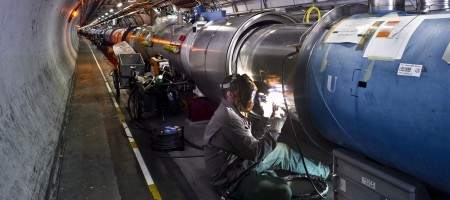Well, no definite proof – but scientists at CERN say they’ve seen ‘tantalising hints’ of the Higgs boson, and that they’ve narrowed the range of mass it could have – if it exists.

They say that the Standard Model Higgs boson, if it exists, is most likely to have a mass in the range 116-130 GeV, going by the results of the ATLAS experiment, and 115-127 GeV according to the parallel CMS experiment.
The Standard Model describes the behaviour of fundamental particles and the forces that act between them, and does a good job where ordinary matter is concerned. What it doesn’t do, though, is describe the 96 percent of the universe that is invisible.
Enter the Higgs boson. If it takes the form known as a Standard Model Higgs boson, it would confirm current theories by explaining why everything in the universe has mass.
If it takes another form, or is found not to exist at all, this would open the door for entirely new physics.
Neither the ATLAS or CMS experiments can observe the Higgs boson directly. But when it decays, it creates particles which can be detected. It’s all about probability: what the scietists are looking for is a surplus of these particles at certain mass ranges.
And this is what they’ve found. It’s certainly not conclusive proof, but it’s enough to get everybody excited.
“We have restricted the most likely mass region for the Higgs boson to 116-130 GeV, and over the last few weeks we have started to see an intriguing excess of events in the mass range around 125 GeV,” says ATLAS experiment spokesperson Fabiola Gianotti.
“This excess may be due to a fluctuation, but it could also be something more interesting. We cannot conclude anything at this stage. We need more study and more data. Given the outstanding performance of the LHC this year, we will not need to wait long for enough data and can look forward to resolving this puzzle in 2012.”
A similar excess has been found with the CMS experiment.
“We cannot exclude the presence of the Standard Model Higgs between 115 and 127 GeV because of a modest excess of events in this mass region that appears, quite consistently, in five independent channels,” says CMS experimentspokesperson, Guido Tonelli.
“The excess is most compatible with a Standard Model Higgs in the vicinity of 124 GeV and below but the statistical significance is not large enough to say anything conclusive. As of today what we see is consistent either with a background fluctuation or with the presence of the boson. Refined analyses and additional data delivered in 2012 by this magnificent machine will definitely give an answer.”
Over the coming months, both experiments will refine their analyses further, aiming to have something to report by the winter particle physics conferences in March.
However, it’s still unlikely that there’ll be enough data for a definitive statement on the existence or non-existence of the Higgs by then: that will probably have to wait until later next year.






